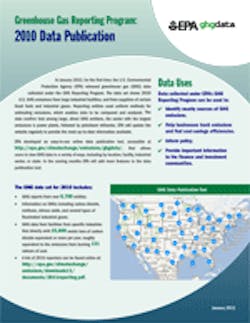The GHG data, which was released Jan. 11 and covers the 2010 calendar year, includes public information from facilities in nine industry groups – power plants, landfills, metals manufacturing, mineral production, petroleum refineries, pulp and paper manufacturing, chemicals manufacturing, government and commercial facilities and other industrial facilities – as well as suppliers of certain fossil fuels.
This is the first time the public could easily view such data reported directly from large facilities and suppliers nationwide. The online data publication tool allows users to view and sort GHG data facility, location, industrial sector and the type of GHG emitted.
The 2010 data reveals:
· Power plants were the largest stationary sources of direct emissions with 2,324 million metric tons of carbon dioxide equivalent (mmtCO2e), followed by petroleum refineries with emissions of 183 mmtCO2e.
· CO2 accounted for the largest share of direct GHG emissions with 95 percent, followed by methane with 4 percent, and nitrous oxide and fluorinated gases accounting for the remaining 1 percent.
· 100 facilities each reported emissions over 7 mmtCO2e, including 96 power plants, two iron and steel mills and two refineries.
EPA launched the GHG Reporting Program in October 2009 to require the reporting of GHG data from large emission sources across a range of industry sectors, as well as suppliers of products that would emit GHGs if released or combusted. Most reporting entities submitted data for calendar year 2010. An additional 12 source categories will begin reporting their 2011 GHG data this year.
Gina McCarthy, assistant administrator for EPA's Office of Air and Radiation, called the GHG Reporting Program "a transparent, powerful data resource."
"The GHG Reporting Program data provide a critical tool for businesses and other innovators to find cost- and fuel-saving efficiencies that reduce greenhouse gas emissions, and foster technologies to protect public health and the environment," said McCarthy.
To access the tool, visit http://epa.gov/climatechange/emissions/ghgdata/. Additional information about the program can be found at http://epa.gov/climatechange/emissions/ghgrulemaking.html.
About the Author

Laura Walter
Laura Walter was formerly senior editor of EHS Today. She is a subject matter expert in EHS compliance and government issues and has covered a variety of topics relating to occupational safety and health. Her writing has earned awards from the American Society of Business Publication Editors (ASBPE), the Trade Association Business Publications International (TABPI) and APEX Awards for Publication Excellence. Her debut novel, Body of Stars (Dutton) was published in 2021.
